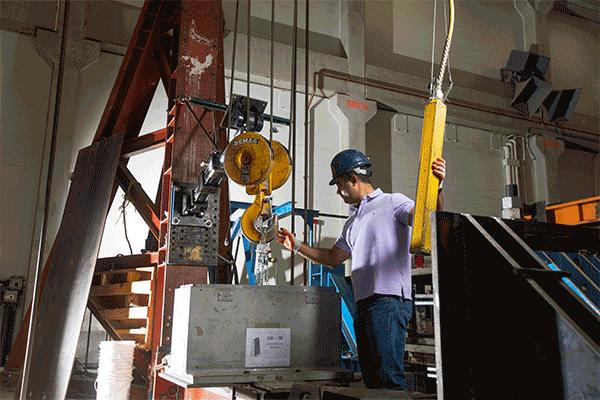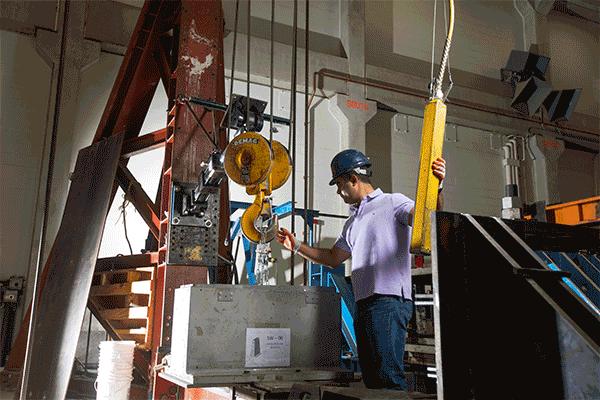
Credit: Credit: Douglas Levere, University at Buffalo.
BUFFALO, N.Y. — Jorge Cueto was running a successful consulting and construction company in Bogota, Colombia, and teaching civil engineering in a university five years ago, but he felt the need to do more. He wanted something new.
"I wrote on the application for the Fulbright scholarship what I was trying to do. I was looking for something new, but I didn't know what it was," he said.
He won the scholarship, and by a fortunate coincidence — one of his favorite professors in Bogota had graduated from the University at Buffalo — he came to UB. After finishing his master's degree and writing his PhD thesis, Cueto recently won UB's Engineering & Applied Sciences Outstanding Young Alumnus Award.
The award is a recognition of outstanding contributions to his career field and comes after a long struggle to win support for his invention, which is also the subject of his thesis: a telescoping structural system. Cueto devised a patent-pending system of telescoping rectangular fiber-reinforced concrete boxes that he hopes will be the basis for "rise on demand" flood walls. The walls can be installed below ground level, so as not to block any water views, and can be raised when the threat of flooding occurs.
NSF grant winner
His invention, called Smart Walls, won a $225,000 Small Business Innovation Research grant from the National Science Foundation. He had earlier won $8,000 in seed funding from the Entrepreneurial Lab, a joint effort of the university's School of Management; Office of Science, Technology Transfer and Economic Outreach; and the undergraduate Entrepreneurship Academy to get the project going.
The inspiration for the telescoping walls came in an emerging technologies class. The assignment was to identify a problem and then design a solution.
"I was literally sitting at my desk in my apartment. I am usually very efficient with space, to optimize its use. When I started thinking of the hollow space inside massive columns. You're not using that space, and I was playing with an umbrella," he recalled.
The idea clicked, and he started designing a telescopic structure.
Cueto, 34, entered numerous business contests in search of money for his fledgling company, Smart Walls Construction LLC. But success eluded him until he received the NSF award.
"The NSF grant was the last straw for me. It allows the company to have a real prototype to be tested and shown to potential clients and investors," Cueto said.
Now his company is occupying space in the UB business incubator on Sweet Home Road in Amherst, New York, and he will continue his research and his fight to launch the company. He is devising a system of gaskets to keep water from entering the walls, which are built of a highly fibrous concrete for extra strength. Expandable flaps that will cover the space between the walls are also being designed.
Thesis idea become a business
Andre Filiatrault, PhD, and Amjad Aref, PhD, both professors in the Civil, Structural and Environmental Engineering Department, have been Cueto's thesis advisors. Both professors knew Cueto was looking to commercialize his idea, but they insisted he not go light on scientific aspects of his thesis.
"We insisted on that," Filiatrault said. "What I admire about Jorge is that he did not shortchange the scientific aspect of his PhD dissertation."
Aref concurred. "Jorge is very industrious, and importantly, possesses very positive attitude toward his work," Aref said. "I hold him in high regard, and wish him all the success in running his company."
In addition to winning the NSF grant, which Filiatrault called almost unprecedented for a student, Cueto is a rare as a civil engineer seeking to develop a business.
"In civil engineering it's much harder to start companies, because the structures we are using are often public structures," Filiatrault said. "Most of our PhD graduates become faculty members or consulting engineers."
Student becomes the boss
Cueto has presented the walls at a meeting of the American Concrete Institute's Strategic Development Council, and had interest from seafront towns. The walls could be useful to protect private property and hospitals, which cannot have access permanently blocked.
Cueto said his professors were supportive of his business plans, but held him to very strict academic standards in his thesis.
"They were very strict on the scientific and technical aspects, and they were right. Innovative structural systems have to be based on strong science," he said.
And Filiatrault notes one bit of irony in Cueto's success. "Now with this NSF grant, Professor Aref and I became consultants on his company, so we are working for him now."
###
Media Contact
Grove Potter
[email protected]
716-645-2130
@UBNewsSource
http://www.buffalo.edu
############
Story Source: Materials provided by Scienmag





